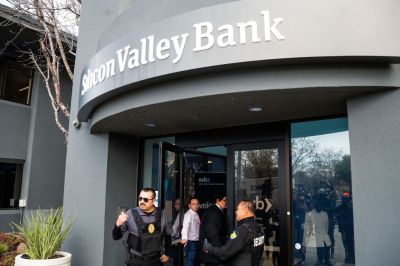On Sunday night, the Treasury, Federal Reserve, and FDIC declared Silicon Valley Bank (SVB) a systemic risk and announced that the federal government would backstop the bank’s customers, allowing them full access to their deposits as of Monday morning. The failure of SVB, which was the 16th largest bank in the U.S., was the first real test of the post-financial crisis regulations put in place under Dodd-Frank to ensure the financial system could withstand the failure of a large bank without spurring contagious bank runs or requiring extraordinary government intervention.
We flunked the test.
We didn’t have to.
SVB’s failure was the perfect opportunity for policymakers to reassure financial markets and the public that our financial system is functioning exactly the way that it should. The U.S. economy is better off with a variety of well-capitalized banks of different sizes with diverse strategies, some of which specialize in a given sector, region, or client type. A bank’s strategy being successful is good for its investors and customers. When its strategy is unsuccessful, the bank should fail, its insured depositors made whole immediately, and its uninsured depositors made whole when the bank or the bank’s assets are sold.
SVB pursued a unique and, until recently, very successful strategy relative to other regional banks. Its client base and loan portfolio were dominated by the tech sector. (Disclaimer: The Dispatch was a Silicon Valley Bank customer.) Its relationships with venture capital firms and young tech firms led its stock to consistently outperform the banking industry as a whole. The low interest rate environment since 2009 combined with the tech sector’s growth made this strategy appear to be a very good bet. But the Federal Reserve has raised interest rates eight times in the past year, from .25 percent to 4.75 percent. Those increases were a double-whammy for SVB, both weakening investment in the tech sector and reducing the value of SVB’s bond portfolios. Rather than wait to see if SVB could raise additional capital to strengthen its balance sheet, SVB’s uninsured depositors quite sensibly headed for the doors. Because SVB was more heavily reliant on uninsured commercial deposits than its competitors, this loss of confidence led to a classic bank run.
In the coming days, officials in the Biden administration will make the case that extraordinary intervention was required so that uninsured commercial depositors would have enough cash to meet payrolls this week. And, that absent an explicit backstop, similarly situated regional banks could have faced bank runs on Monday from their uninsured depositors. The administration will also assure the public that making the depositors whole will not cost the taxpayer a cent. And, that this is evidence that we need more restrictive banking regulations of banks to ensure that this never happens again.
None of these statements is true.
Firms needing cash to fund payrolls could still have drawn upon their accounts at SVB. Reports from early Sunday indicated that initial payments would be between 30 and 50 percent of uninsured deposits, meaning that only firms with less than 50 days worth of payroll in cash-on-hand would have trouble paying their workers this week. Those that needed additional, short-term funding could find a different source of credit until a buyer for SVB was found or sufficient assets were sold to make commercial depositors whole.
While some other banks may have come under pressure, SVB was singular both in its focus on the tech sector and its reliance on commercial deposits. Most regional banks, in contrast, work with different industries and rely more heavily on insured retail deposits. The Biden administration could have used SVB’s failure to remind the public that all retail deposits have a $250,000 FDIC guarantee and that all of SVB’s customers continue to have access to their funds up to this amount, stemming the potential for contagion.
Allowing the FDIC to use its normal playbook for resolving a failed bank would also have reminded capital markets about the risks associated with financial institutions that make big bets on single sectors. For Washington Mutual and the other banks that failed (or would have failed) in 2008, it was housing. For SVB in 2023, it’s tech. If depositors run from other banks that rely too heavily on uninsured commercial deposits or whose business lines are too dependent on low interest rates in perpetuity, this is creative destruction, not contagion.
Further, declaring SVB a systemic risk absolutely comes at a cost to the taxpayer. But backstopping SVB’s uninsured depositors means that risk is being shifted from depositors to the FDIC, the Federal Reserve, and ultimately the American public. Any costs to the FDIC resulting from insuring SVB’s commercial depositors will be funded by a future tax on banks, which will then be partially passed along to consumers. The new Federal Reserve facility that was created on Sunday to make secured loans so that other banks like SVB do not face a bank run in the future is an implicit taxpayer subsidy to banks that failed to manage interrelated interest rate and liquidity risks.
Finally, every time the government determines a bank is too big, too important, too interconnected, or too contagious to fail, it increases the moral hazard in the banking system, leading to calls for new regulations that make it harder for banks to take the kinds of risks that, in good times, pay off for their shareholders, support ecosystems of new firms, and promote the dynamism of the U.S. economy.






Please note that we at The Dispatch hold ourselves, our work, and our commenters to a higher standard than other places on the internet. We welcome comments that foster genuine debate or discussion—including comments critical of us or our work—but responses that include ad hominem attacks on fellow Dispatch members or are intended to stoke fear and anger may be moderated.
With your membership, you only have the ability to comment on The Morning Dispatch articles. Consider upgrading to join the conversation everywhere.